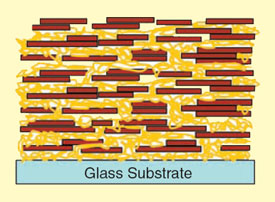Scientists at the University of Michigan, US, have created a transparent material with the strength and stiffness of body armour by layering nanoplates of clay between a common polymer.
The material combines high transparency and flexibility with tensile strength comparable to some grades of Kevlar. The material is layered, which allows the clay mineral 'plates' to align well enough to join strongly with polyvinyl alcohol - a polymer found in glue. When the material has a force applied to it, the polymer transfers the load onto the stronger mineral.
The problem in making this kind of composite has been transfer of the clay plates' nanoscale properties - such as their high tensile strength and stiffness - to the polymer they're held in.
Layer-by-layer, or LBL, is how the team led by Nicolas Kotov describes the technique. With a 'from the bottom up' approach the composite is constructed one layer at a time, allowing for uniform spacing of the plates and very efficient binding between the mineral and polymer. This process is slow but can be carefully controlled to give the material its unique characteristics. The researchers also used a cross-linking additive to promote very strong chemical bonds between the clay plates and the polymer.

The 'bricks and mortar' building approach strengthens the new material
© Nicolas Kotov
|
Kotov feels there are many exciting possibilities for this composite. 'Primary applications I see include microelectronic devices, microfluidics and biomedical devices - the transparency of the material is particularly conducive to these applications.' He also feels the strength of the material may help with development of 'new types of armour and unmanned aerial vehicles'. His colleague Anthony Waas added that new research by the group will 'demonstrate the applications of these materials where stiffness, strength and toughness are all equally important.'
Richard Pethrick, a professor working on epoxy composites at the University of Strathclyde, doubts that it will be worth scaling up the process for manufacture. 'The work is interesting and the material shows interesting properties, given by the good cross-linking,' he told Chemistry World. 'The question is, however, if the composite is actually more appropriate than others for the potential applications.'
Jonathan Edwards




